Detailed Report: Management of Organizational Activities - Unit 4
VerifiedAdded on 2022/10/19
|11
|1611
|51
Report
AI Summary
This report delves into the multifaceted aspects of managing organizational activities, providing a comprehensive overview of key concepts and practical applications. It begins by examining the significance of an organization's mission and vision, exploring how these foundational elements shape its structure and culture. The report then explores the importance of organizational structure and culture, and how they impact the effectiveness of a business. It then transitions into a discussion of various techniques and models used in managing business activities, including customer orientation, operational management, and project management methodologies. The report also covers the development of work plans, including setting objectives and quality standards. Furthermore, it addresses crucial aspects of managing business activities, such as delegation decisions, monitoring work, and the importance of health and safety legislation. Finally, the report concludes with a discussion of risk assessments and their role in ensuring a safe and productive work environment. The report is a valuable resource for students studying leadership and management, offering insights into the core principles and practices of effective organizational management.
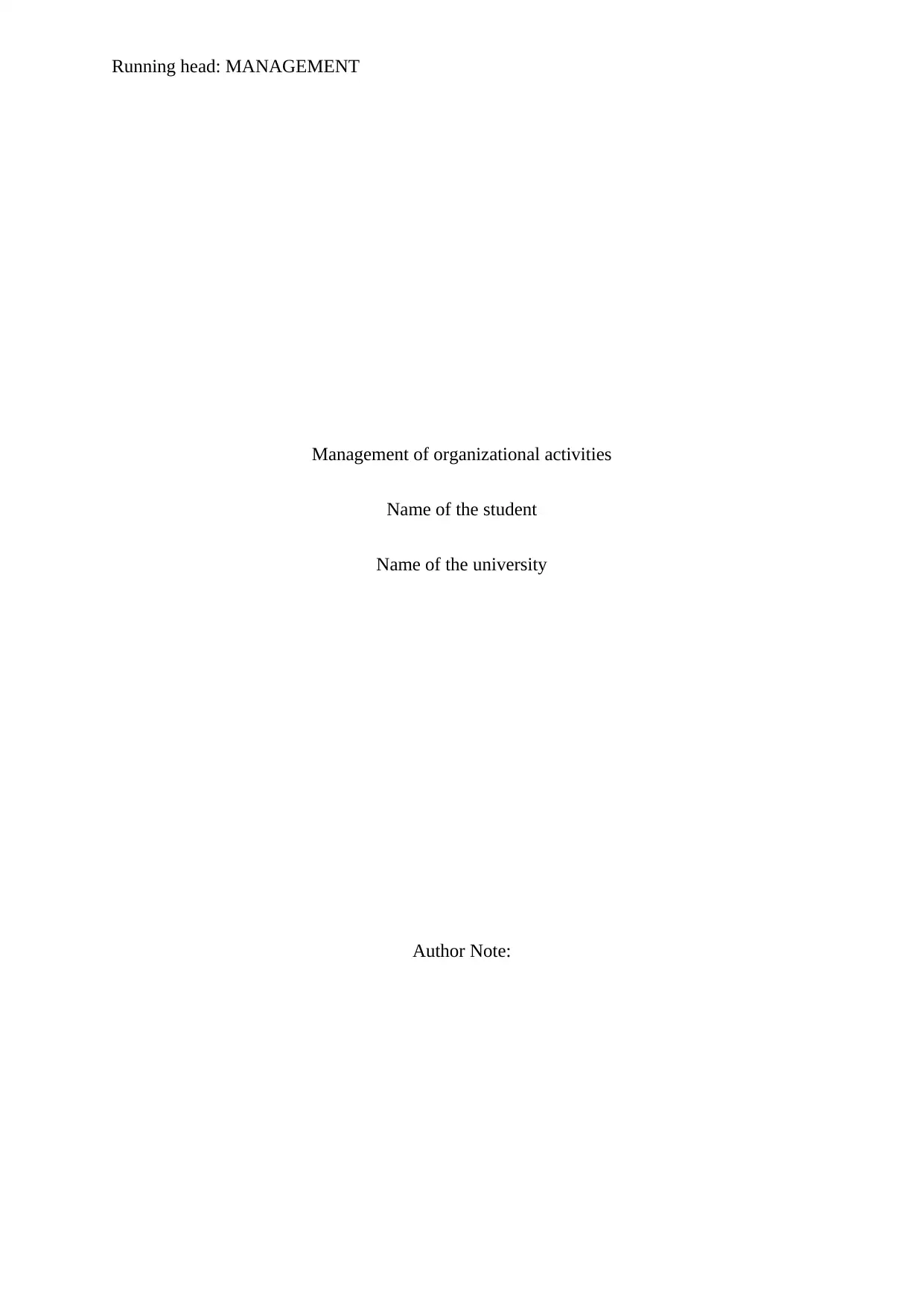
Running head: MANAGEMENT
Management of organizational activities
Name of the student
Name of the university
Author Note:
Management of organizational activities
Name of the student
Name of the university
Author Note:
Paraphrase This Document
Need a fresh take? Get an instant paraphrase of this document with our AI Paraphraser
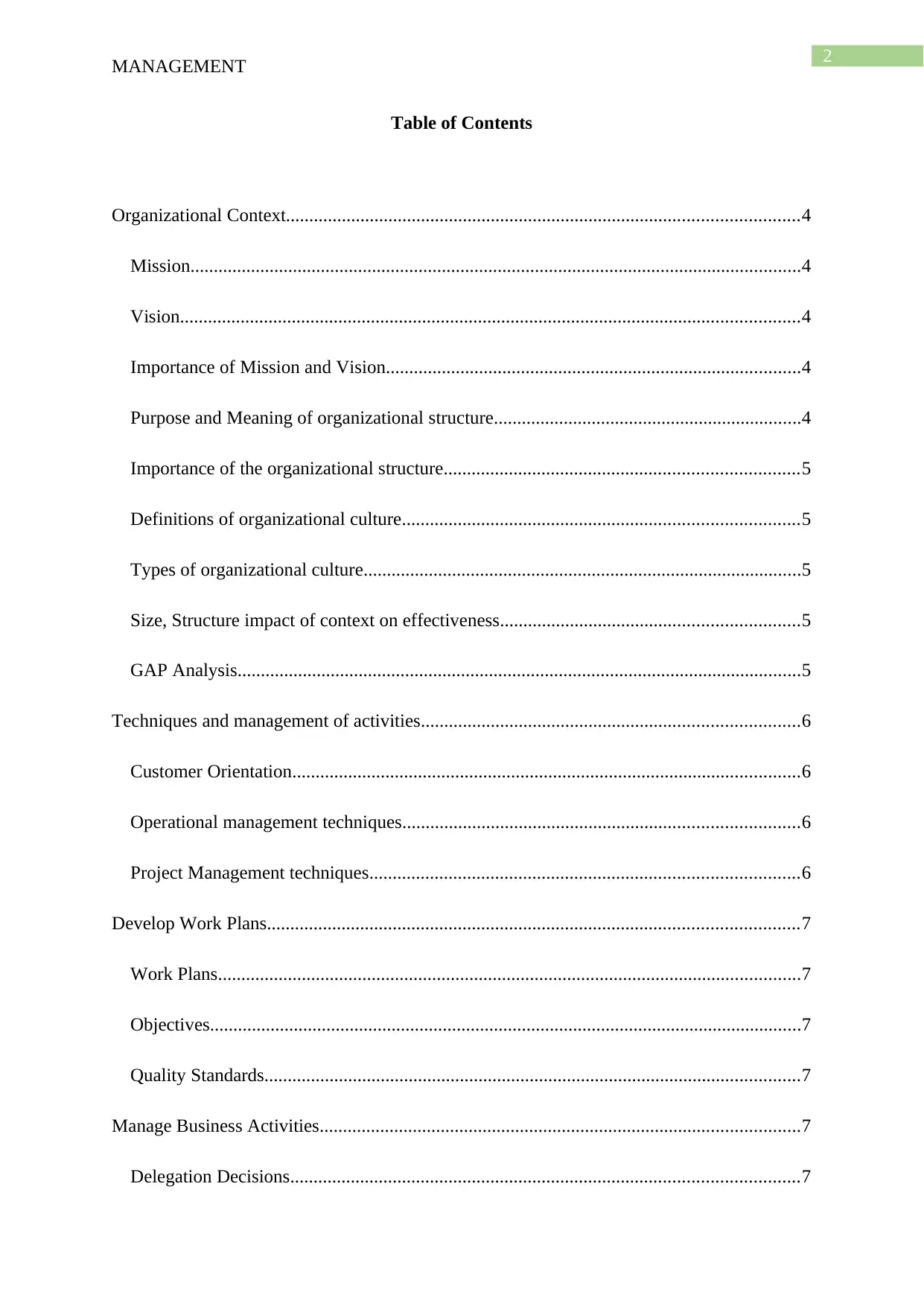
2
MANAGEMENT
Table of Contents
Organizational Context..............................................................................................................4
Mission...................................................................................................................................4
Vision.....................................................................................................................................4
Importance of Mission and Vision.........................................................................................4
Purpose and Meaning of organizational structure..................................................................4
Importance of the organizational structure............................................................................5
Definitions of organizational culture.....................................................................................5
Types of organizational culture..............................................................................................5
Size, Structure impact of context on effectiveness................................................................5
GAP Analysis.........................................................................................................................5
Techniques and management of activities.................................................................................6
Customer Orientation.............................................................................................................6
Operational management techniques.....................................................................................6
Project Management techniques............................................................................................6
Develop Work Plans..................................................................................................................7
Work Plans.............................................................................................................................7
Objectives...............................................................................................................................7
Quality Standards...................................................................................................................7
Manage Business Activities.......................................................................................................7
Delegation Decisions.............................................................................................................7
MANAGEMENT
Table of Contents
Organizational Context..............................................................................................................4
Mission...................................................................................................................................4
Vision.....................................................................................................................................4
Importance of Mission and Vision.........................................................................................4
Purpose and Meaning of organizational structure..................................................................4
Importance of the organizational structure............................................................................5
Definitions of organizational culture.....................................................................................5
Types of organizational culture..............................................................................................5
Size, Structure impact of context on effectiveness................................................................5
GAP Analysis.........................................................................................................................5
Techniques and management of activities.................................................................................6
Customer Orientation.............................................................................................................6
Operational management techniques.....................................................................................6
Project Management techniques............................................................................................6
Develop Work Plans..................................................................................................................7
Work Plans.............................................................................................................................7
Objectives...............................................................................................................................7
Quality Standards...................................................................................................................7
Manage Business Activities.......................................................................................................7
Delegation Decisions.............................................................................................................7
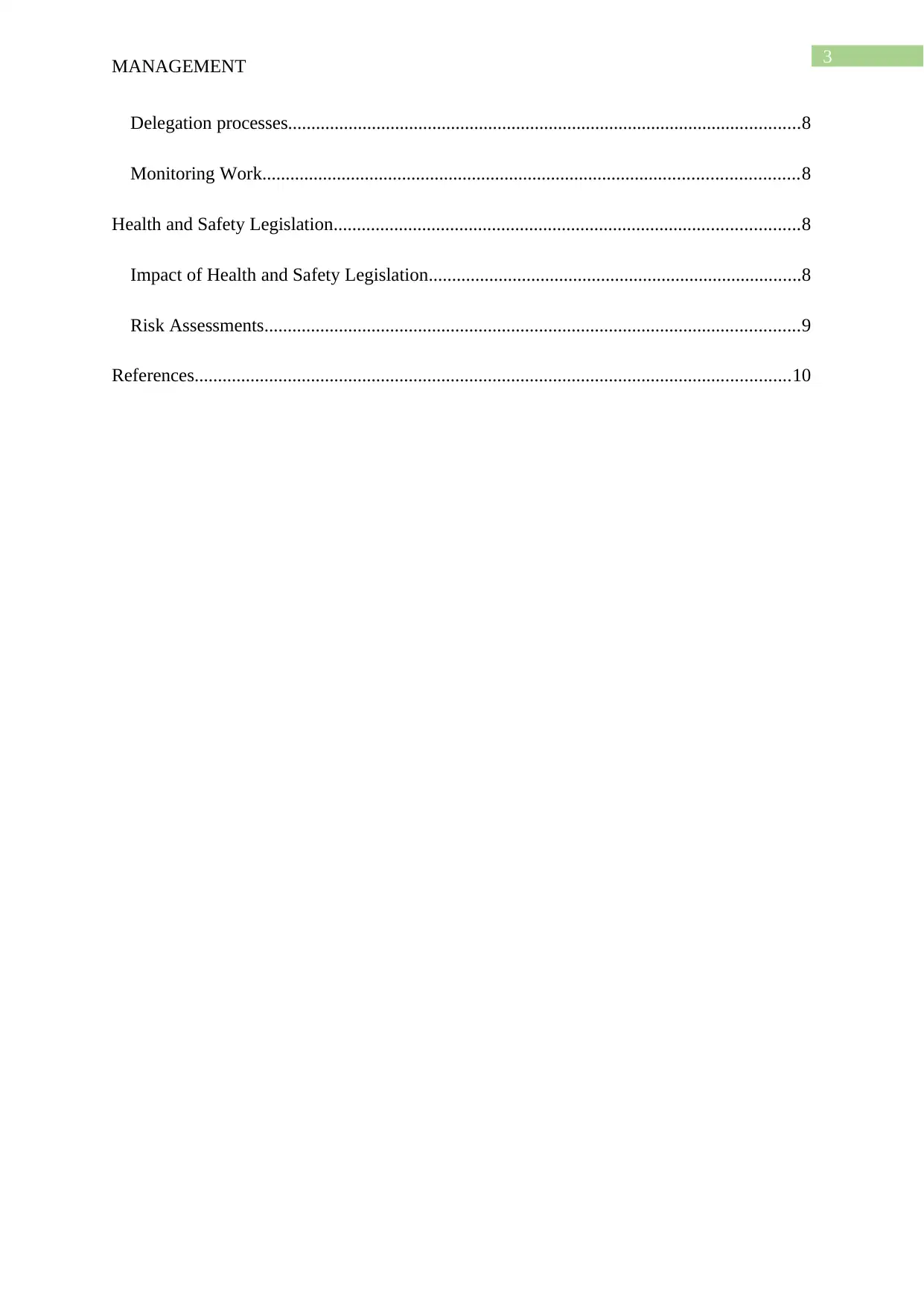
3
MANAGEMENT
Delegation processes..............................................................................................................8
Monitoring Work...................................................................................................................8
Health and Safety Legislation....................................................................................................8
Impact of Health and Safety Legislation................................................................................8
Risk Assessments...................................................................................................................9
References................................................................................................................................10
MANAGEMENT
Delegation processes..............................................................................................................8
Monitoring Work...................................................................................................................8
Health and Safety Legislation....................................................................................................8
Impact of Health and Safety Legislation................................................................................8
Risk Assessments...................................................................................................................9
References................................................................................................................................10
⊘ This is a preview!⊘
Do you want full access?
Subscribe today to unlock all pages.

Trusted by 1+ million students worldwide
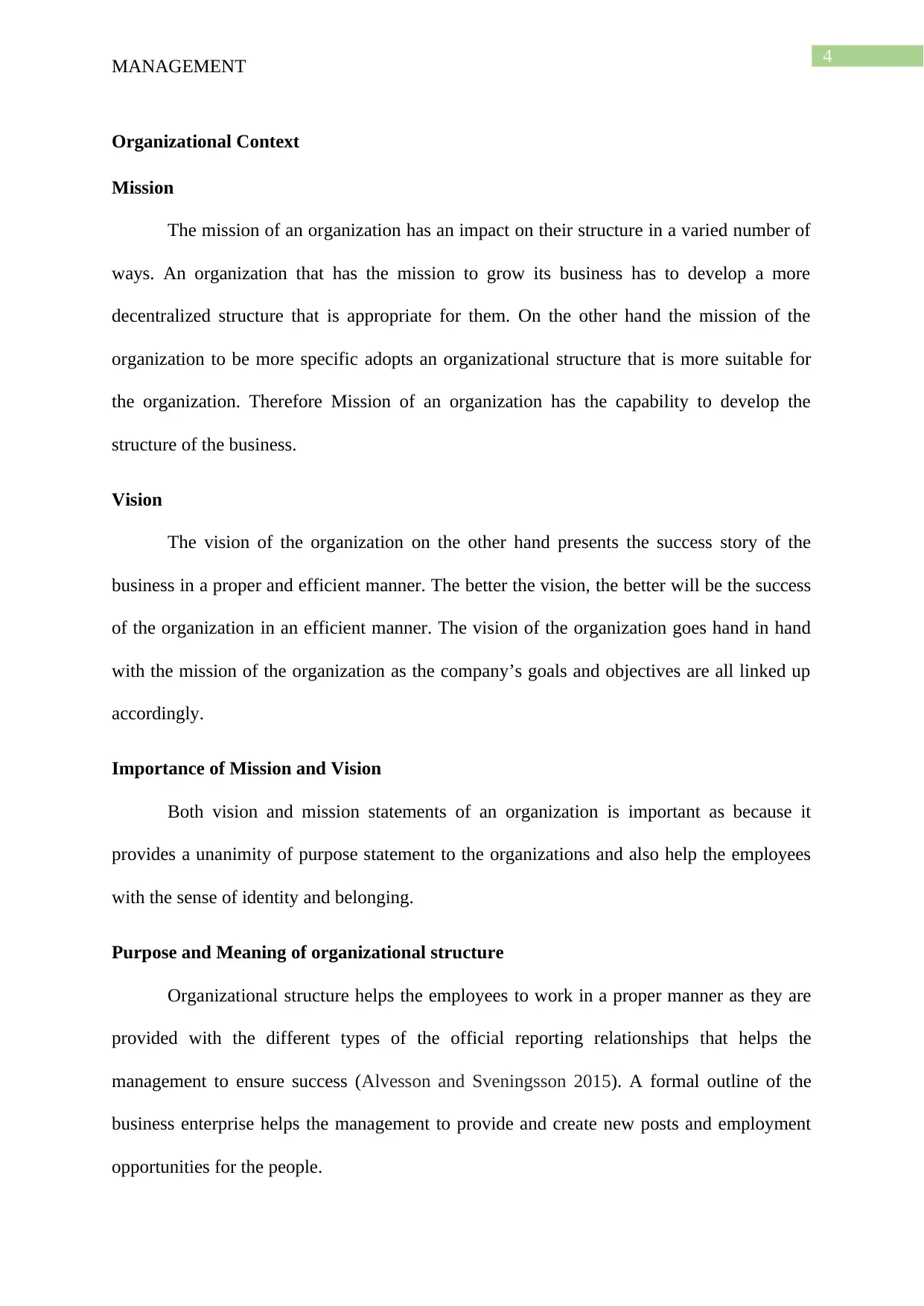
4
MANAGEMENT
Organizational Context
Mission
The mission of an organization has an impact on their structure in a varied number of
ways. An organization that has the mission to grow its business has to develop a more
decentralized structure that is appropriate for them. On the other hand the mission of the
organization to be more specific adopts an organizational structure that is more suitable for
the organization. Therefore Mission of an organization has the capability to develop the
structure of the business.
Vision
The vision of the organization on the other hand presents the success story of the
business in a proper and efficient manner. The better the vision, the better will be the success
of the organization in an efficient manner. The vision of the organization goes hand in hand
with the mission of the organization as the company’s goals and objectives are all linked up
accordingly.
Importance of Mission and Vision
Both vision and mission statements of an organization is important as because it
provides a unanimity of purpose statement to the organizations and also help the employees
with the sense of identity and belonging.
Purpose and Meaning of organizational structure
Organizational structure helps the employees to work in a proper manner as they are
provided with the different types of the official reporting relationships that helps the
management to ensure success (Alvesson and Sveningsson 2015). A formal outline of the
business enterprise helps the management to provide and create new posts and employment
opportunities for the people.
MANAGEMENT
Organizational Context
Mission
The mission of an organization has an impact on their structure in a varied number of
ways. An organization that has the mission to grow its business has to develop a more
decentralized structure that is appropriate for them. On the other hand the mission of the
organization to be more specific adopts an organizational structure that is more suitable for
the organization. Therefore Mission of an organization has the capability to develop the
structure of the business.
Vision
The vision of the organization on the other hand presents the success story of the
business in a proper and efficient manner. The better the vision, the better will be the success
of the organization in an efficient manner. The vision of the organization goes hand in hand
with the mission of the organization as the company’s goals and objectives are all linked up
accordingly.
Importance of Mission and Vision
Both vision and mission statements of an organization is important as because it
provides a unanimity of purpose statement to the organizations and also help the employees
with the sense of identity and belonging.
Purpose and Meaning of organizational structure
Organizational structure helps the employees to work in a proper manner as they are
provided with the different types of the official reporting relationships that helps the
management to ensure success (Alvesson and Sveningsson 2015). A formal outline of the
business enterprise helps the management to provide and create new posts and employment
opportunities for the people.
Paraphrase This Document
Need a fresh take? Get an instant paraphrase of this document with our AI Paraphraser
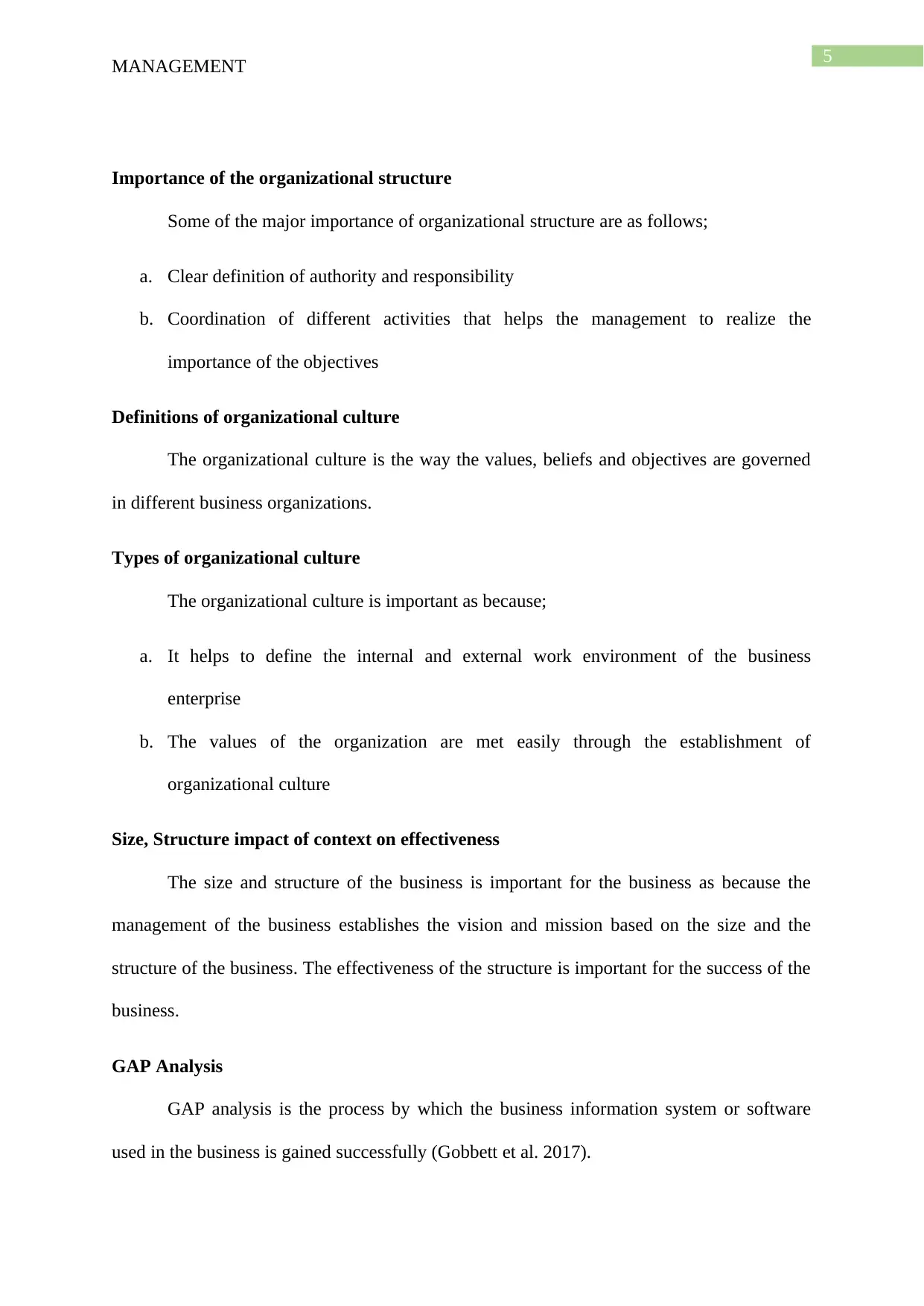
5
MANAGEMENT
Importance of the organizational structure
Some of the major importance of organizational structure are as follows;
a. Clear definition of authority and responsibility
b. Coordination of different activities that helps the management to realize the
importance of the objectives
Definitions of organizational culture
The organizational culture is the way the values, beliefs and objectives are governed
in different business organizations.
Types of organizational culture
The organizational culture is important as because;
a. It helps to define the internal and external work environment of the business
enterprise
b. The values of the organization are met easily through the establishment of
organizational culture
Size, Structure impact of context on effectiveness
The size and structure of the business is important for the business as because the
management of the business establishes the vision and mission based on the size and the
structure of the business. The effectiveness of the structure is important for the success of the
business.
GAP Analysis
GAP analysis is the process by which the business information system or software
used in the business is gained successfully (Gobbett et al. 2017).
MANAGEMENT
Importance of the organizational structure
Some of the major importance of organizational structure are as follows;
a. Clear definition of authority and responsibility
b. Coordination of different activities that helps the management to realize the
importance of the objectives
Definitions of organizational culture
The organizational culture is the way the values, beliefs and objectives are governed
in different business organizations.
Types of organizational culture
The organizational culture is important as because;
a. It helps to define the internal and external work environment of the business
enterprise
b. The values of the organization are met easily through the establishment of
organizational culture
Size, Structure impact of context on effectiveness
The size and structure of the business is important for the business as because the
management of the business establishes the vision and mission based on the size and the
structure of the business. The effectiveness of the structure is important for the success of the
business.
GAP Analysis
GAP analysis is the process by which the business information system or software
used in the business is gained successfully (Gobbett et al. 2017).
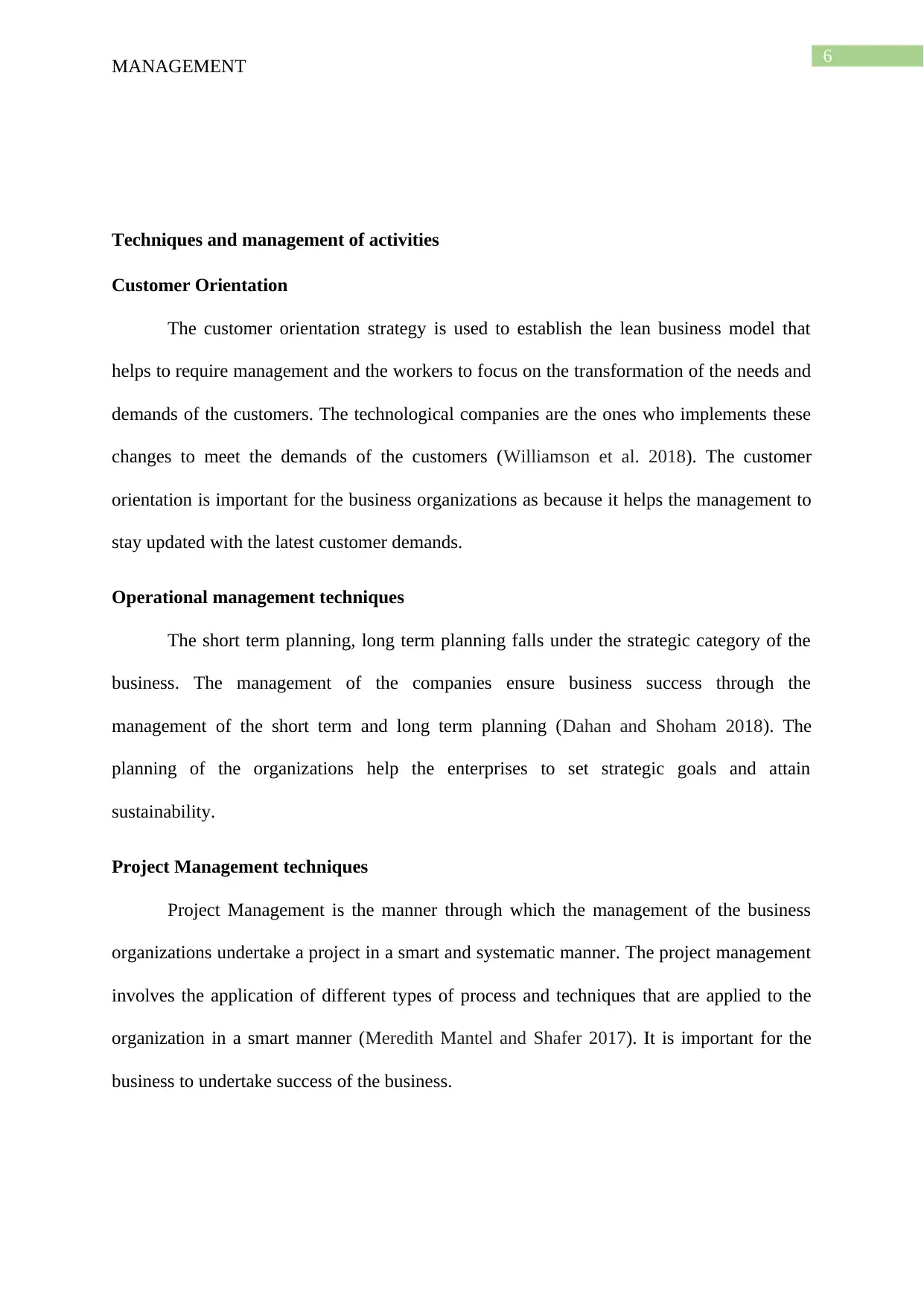
6
MANAGEMENT
Techniques and management of activities
Customer Orientation
The customer orientation strategy is used to establish the lean business model that
helps to require management and the workers to focus on the transformation of the needs and
demands of the customers. The technological companies are the ones who implements these
changes to meet the demands of the customers (Williamson et al. 2018). The customer
orientation is important for the business organizations as because it helps the management to
stay updated with the latest customer demands.
Operational management techniques
The short term planning, long term planning falls under the strategic category of the
business. The management of the companies ensure business success through the
management of the short term and long term planning (Dahan and Shoham 2018). The
planning of the organizations help the enterprises to set strategic goals and attain
sustainability.
Project Management techniques
Project Management is the manner through which the management of the business
organizations undertake a project in a smart and systematic manner. The project management
involves the application of different types of process and techniques that are applied to the
organization in a smart manner (Meredith Mantel and Shafer 2017). It is important for the
business to undertake success of the business.
MANAGEMENT
Techniques and management of activities
Customer Orientation
The customer orientation strategy is used to establish the lean business model that
helps to require management and the workers to focus on the transformation of the needs and
demands of the customers. The technological companies are the ones who implements these
changes to meet the demands of the customers (Williamson et al. 2018). The customer
orientation is important for the business organizations as because it helps the management to
stay updated with the latest customer demands.
Operational management techniques
The short term planning, long term planning falls under the strategic category of the
business. The management of the companies ensure business success through the
management of the short term and long term planning (Dahan and Shoham 2018). The
planning of the organizations help the enterprises to set strategic goals and attain
sustainability.
Project Management techniques
Project Management is the manner through which the management of the business
organizations undertake a project in a smart and systematic manner. The project management
involves the application of different types of process and techniques that are applied to the
organization in a smart manner (Meredith Mantel and Shafer 2017). It is important for the
business to undertake success of the business.
⊘ This is a preview!⊘
Do you want full access?
Subscribe today to unlock all pages.

Trusted by 1+ million students worldwide
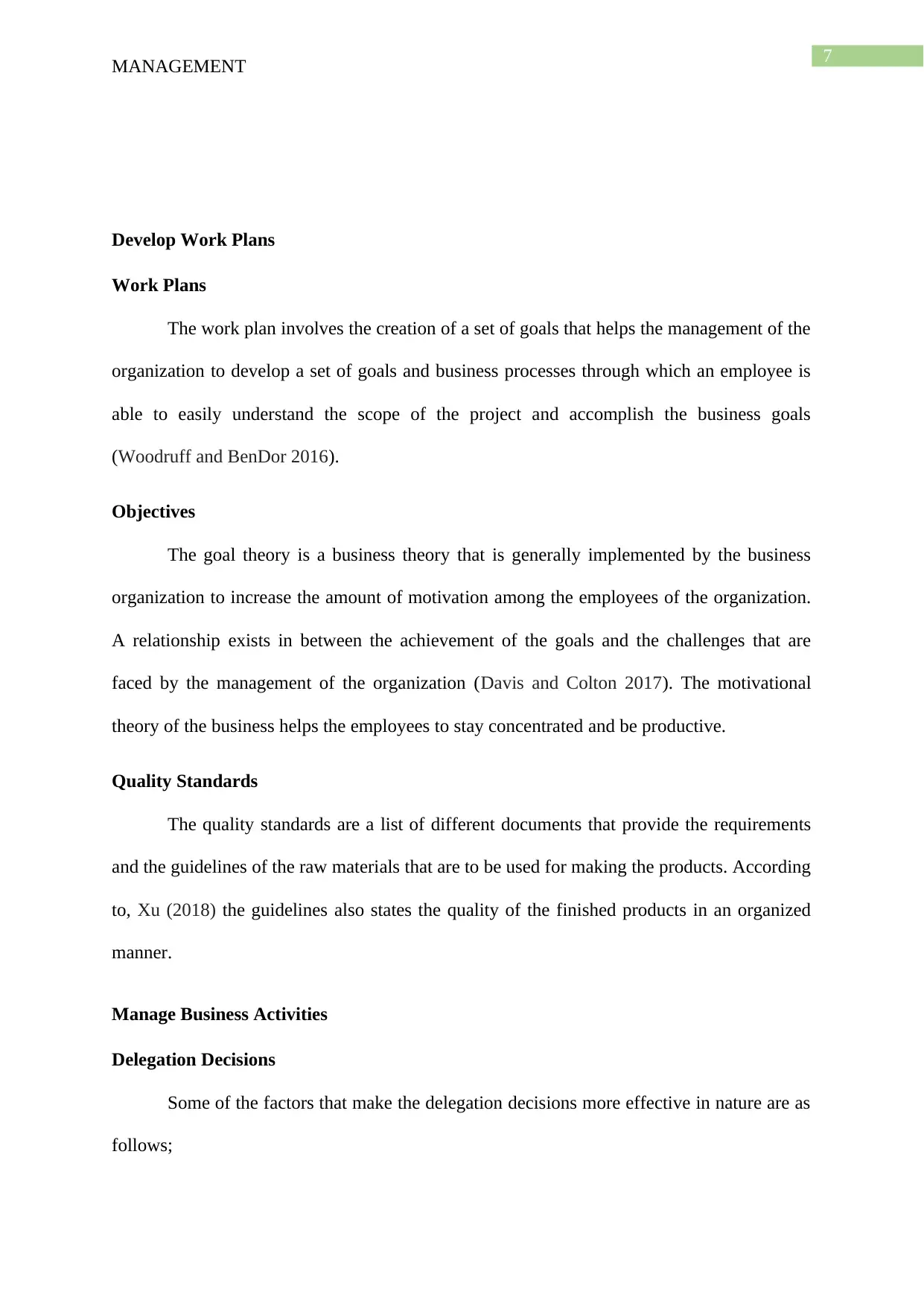
7
MANAGEMENT
Develop Work Plans
Work Plans
The work plan involves the creation of a set of goals that helps the management of the
organization to develop a set of goals and business processes through which an employee is
able to easily understand the scope of the project and accomplish the business goals
(Woodruff and BenDor 2016).
Objectives
The goal theory is a business theory that is generally implemented by the business
organization to increase the amount of motivation among the employees of the organization.
A relationship exists in between the achievement of the goals and the challenges that are
faced by the management of the organization (Davis and Colton 2017). The motivational
theory of the business helps the employees to stay concentrated and be productive.
Quality Standards
The quality standards are a list of different documents that provide the requirements
and the guidelines of the raw materials that are to be used for making the products. According
to, Xu (2018) the guidelines also states the quality of the finished products in an organized
manner.
Manage Business Activities
Delegation Decisions
Some of the factors that make the delegation decisions more effective in nature are as
follows;
MANAGEMENT
Develop Work Plans
Work Plans
The work plan involves the creation of a set of goals that helps the management of the
organization to develop a set of goals and business processes through which an employee is
able to easily understand the scope of the project and accomplish the business goals
(Woodruff and BenDor 2016).
Objectives
The goal theory is a business theory that is generally implemented by the business
organization to increase the amount of motivation among the employees of the organization.
A relationship exists in between the achievement of the goals and the challenges that are
faced by the management of the organization (Davis and Colton 2017). The motivational
theory of the business helps the employees to stay concentrated and be productive.
Quality Standards
The quality standards are a list of different documents that provide the requirements
and the guidelines of the raw materials that are to be used for making the products. According
to, Xu (2018) the guidelines also states the quality of the finished products in an organized
manner.
Manage Business Activities
Delegation Decisions
Some of the factors that make the delegation decisions more effective in nature are as
follows;
Paraphrase This Document
Need a fresh take? Get an instant paraphrase of this document with our AI Paraphraser
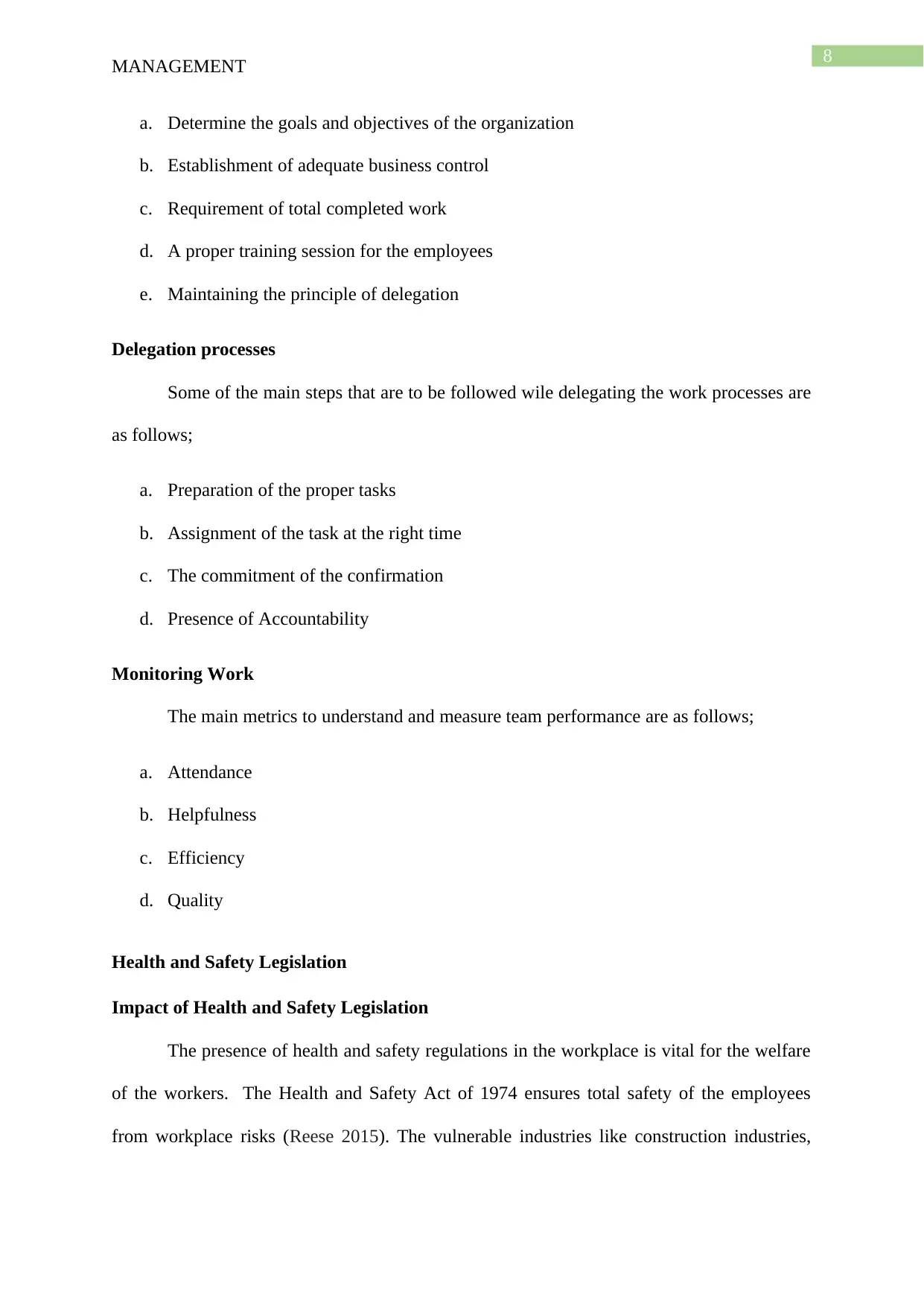
8
MANAGEMENT
a. Determine the goals and objectives of the organization
b. Establishment of adequate business control
c. Requirement of total completed work
d. A proper training session for the employees
e. Maintaining the principle of delegation
Delegation processes
Some of the main steps that are to be followed wile delegating the work processes are
as follows;
a. Preparation of the proper tasks
b. Assignment of the task at the right time
c. The commitment of the confirmation
d. Presence of Accountability
Monitoring Work
The main metrics to understand and measure team performance are as follows;
a. Attendance
b. Helpfulness
c. Efficiency
d. Quality
Health and Safety Legislation
Impact of Health and Safety Legislation
The presence of health and safety regulations in the workplace is vital for the welfare
of the workers. The Health and Safety Act of 1974 ensures total safety of the employees
from workplace risks (Reese 2015). The vulnerable industries like construction industries,
MANAGEMENT
a. Determine the goals and objectives of the organization
b. Establishment of adequate business control
c. Requirement of total completed work
d. A proper training session for the employees
e. Maintaining the principle of delegation
Delegation processes
Some of the main steps that are to be followed wile delegating the work processes are
as follows;
a. Preparation of the proper tasks
b. Assignment of the task at the right time
c. The commitment of the confirmation
d. Presence of Accountability
Monitoring Work
The main metrics to understand and measure team performance are as follows;
a. Attendance
b. Helpfulness
c. Efficiency
d. Quality
Health and Safety Legislation
Impact of Health and Safety Legislation
The presence of health and safety regulations in the workplace is vital for the welfare
of the workers. The Health and Safety Act of 1974 ensures total safety of the employees
from workplace risks (Reese 2015). The vulnerable industries like construction industries,
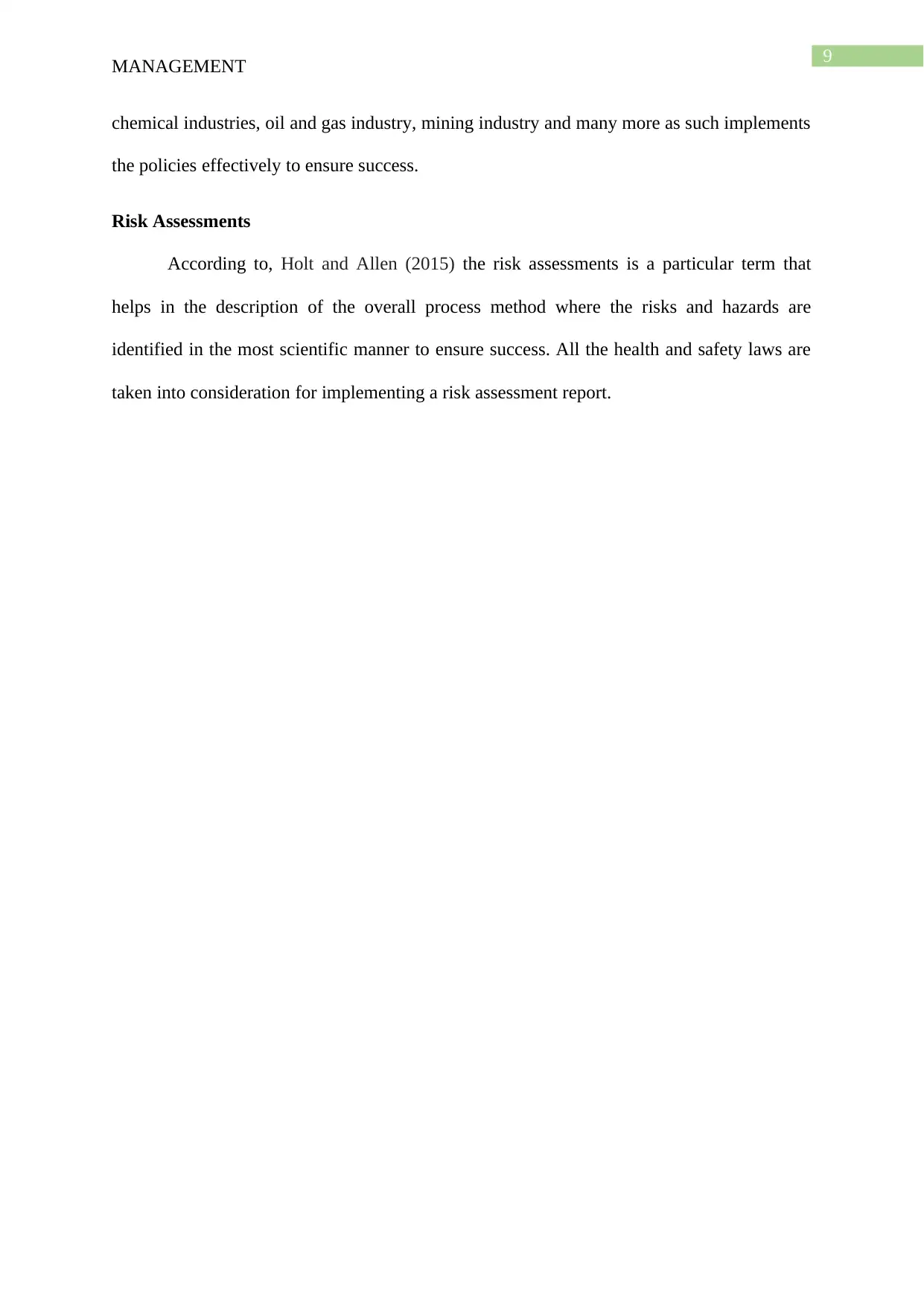
9
MANAGEMENT
chemical industries, oil and gas industry, mining industry and many more as such implements
the policies effectively to ensure success.
Risk Assessments
According to, Holt and Allen (2015) the risk assessments is a particular term that
helps in the description of the overall process method where the risks and hazards are
identified in the most scientific manner to ensure success. All the health and safety laws are
taken into consideration for implementing a risk assessment report.
MANAGEMENT
chemical industries, oil and gas industry, mining industry and many more as such implements
the policies effectively to ensure success.
Risk Assessments
According to, Holt and Allen (2015) the risk assessments is a particular term that
helps in the description of the overall process method where the risks and hazards are
identified in the most scientific manner to ensure success. All the health and safety laws are
taken into consideration for implementing a risk assessment report.
⊘ This is a preview!⊘
Do you want full access?
Subscribe today to unlock all pages.

Trusted by 1+ million students worldwide
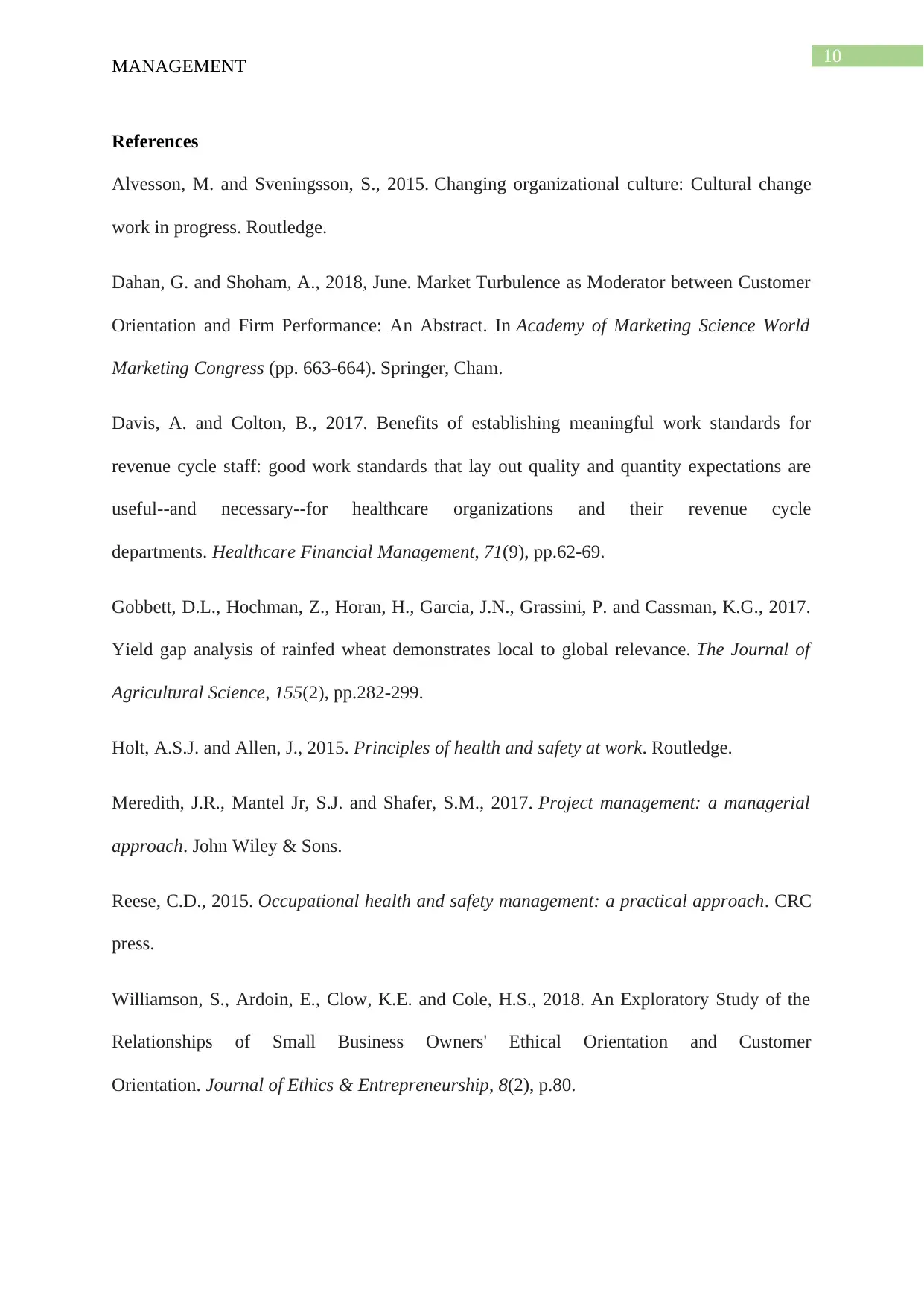
10
MANAGEMENT
References
Alvesson, M. and Sveningsson, S., 2015. Changing organizational culture: Cultural change
work in progress. Routledge.
Dahan, G. and Shoham, A., 2018, June. Market Turbulence as Moderator between Customer
Orientation and Firm Performance: An Abstract. In Academy of Marketing Science World
Marketing Congress (pp. 663-664). Springer, Cham.
Davis, A. and Colton, B., 2017. Benefits of establishing meaningful work standards for
revenue cycle staff: good work standards that lay out quality and quantity expectations are
useful--and necessary--for healthcare organizations and their revenue cycle
departments. Healthcare Financial Management, 71(9), pp.62-69.
Gobbett, D.L., Hochman, Z., Horan, H., Garcia, J.N., Grassini, P. and Cassman, K.G., 2017.
Yield gap analysis of rainfed wheat demonstrates local to global relevance. The Journal of
Agricultural Science, 155(2), pp.282-299.
Holt, A.S.J. and Allen, J., 2015. Principles of health and safety at work. Routledge.
Meredith, J.R., Mantel Jr, S.J. and Shafer, S.M., 2017. Project management: a managerial
approach. John Wiley & Sons.
Reese, C.D., 2015. Occupational health and safety management: a practical approach. CRC
press.
Williamson, S., Ardoin, E., Clow, K.E. and Cole, H.S., 2018. An Exploratory Study of the
Relationships of Small Business Owners' Ethical Orientation and Customer
Orientation. Journal of Ethics & Entrepreneurship, 8(2), p.80.
MANAGEMENT
References
Alvesson, M. and Sveningsson, S., 2015. Changing organizational culture: Cultural change
work in progress. Routledge.
Dahan, G. and Shoham, A., 2018, June. Market Turbulence as Moderator between Customer
Orientation and Firm Performance: An Abstract. In Academy of Marketing Science World
Marketing Congress (pp. 663-664). Springer, Cham.
Davis, A. and Colton, B., 2017. Benefits of establishing meaningful work standards for
revenue cycle staff: good work standards that lay out quality and quantity expectations are
useful--and necessary--for healthcare organizations and their revenue cycle
departments. Healthcare Financial Management, 71(9), pp.62-69.
Gobbett, D.L., Hochman, Z., Horan, H., Garcia, J.N., Grassini, P. and Cassman, K.G., 2017.
Yield gap analysis of rainfed wheat demonstrates local to global relevance. The Journal of
Agricultural Science, 155(2), pp.282-299.
Holt, A.S.J. and Allen, J., 2015. Principles of health and safety at work. Routledge.
Meredith, J.R., Mantel Jr, S.J. and Shafer, S.M., 2017. Project management: a managerial
approach. John Wiley & Sons.
Reese, C.D., 2015. Occupational health and safety management: a practical approach. CRC
press.
Williamson, S., Ardoin, E., Clow, K.E. and Cole, H.S., 2018. An Exploratory Study of the
Relationships of Small Business Owners' Ethical Orientation and Customer
Orientation. Journal of Ethics & Entrepreneurship, 8(2), p.80.
Paraphrase This Document
Need a fresh take? Get an instant paraphrase of this document with our AI Paraphraser
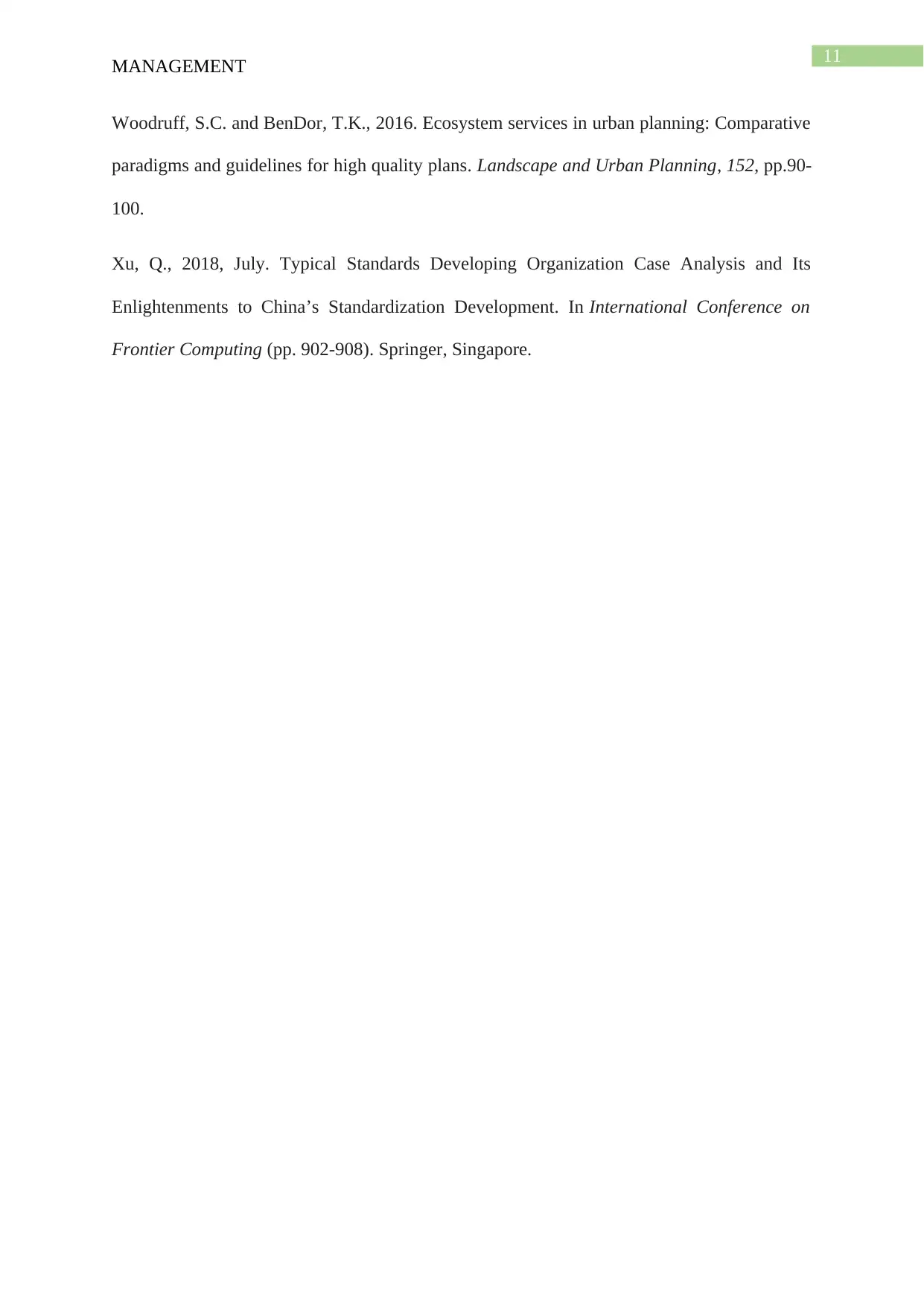
11
MANAGEMENT
Woodruff, S.C. and BenDor, T.K., 2016. Ecosystem services in urban planning: Comparative
paradigms and guidelines for high quality plans. Landscape and Urban Planning, 152, pp.90-
100.
Xu, Q., 2018, July. Typical Standards Developing Organization Case Analysis and Its
Enlightenments to China’s Standardization Development. In International Conference on
Frontier Computing (pp. 902-908). Springer, Singapore.
MANAGEMENT
Woodruff, S.C. and BenDor, T.K., 2016. Ecosystem services in urban planning: Comparative
paradigms and guidelines for high quality plans. Landscape and Urban Planning, 152, pp.90-
100.
Xu, Q., 2018, July. Typical Standards Developing Organization Case Analysis and Its
Enlightenments to China’s Standardization Development. In International Conference on
Frontier Computing (pp. 902-908). Springer, Singapore.
1 out of 11
Related Documents
Your All-in-One AI-Powered Toolkit for Academic Success.
+13062052269
info@desklib.com
Available 24*7 on WhatsApp / Email
![[object Object]](/_next/static/media/star-bottom.7253800d.svg)
Unlock your academic potential
Copyright © 2020–2025 A2Z Services. All Rights Reserved. Developed and managed by ZUCOL.




